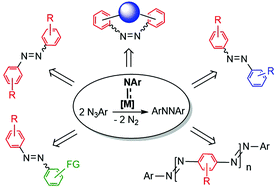Catalytic synthesis of azoarenes via metal-mediated nitrene coupling
Abstract
Various valuable properties of azoarenes (“azo dyes”), including their vivid colors and their facile cis–trans photoisomerization, lead to their wide use in the chemical industry. As a result, ∼700 000 metric tons of azo dyes are produced each year. Most currently utilized synthetic methods towards azoarenes involve harsh reaction conditions and/or toxic reagents in stoichiometric amounts, which may affect selectivity and produce significant amounts of waste. An efficient alternative method towards this functional group includes transition metal catalyzed nitrene coupling. This method is generally more sustainable compared with most stoichiometric methods as it uses only catalytic amounts of co-reactants (metal catalysts), requires easily synthesizable organoazide precursors, and forms only dinitrogen as a by-product of catalysis. During the last decade, several catalytic systems were reported, and their reactivity was investigated. This perspective article will review these systems, focusing on various nitrene coupling mechanisms, and the substrate scope for each system. Particular attention will be devoted to the iron-alkoxide catalytic systems investigated in the PI's laboratory. The design and structural features of several generations of iron bis(alkoxide) complexes will be discussed, followed by the structure–activity studies of these catalysts in nitrene homo- and heterocoupling.

- This article is part of the themed collection: 2022 Frontier and Perspective articles


 Please wait while we load your content...
Please wait while we load your content...